 |
||
|
||
| ||
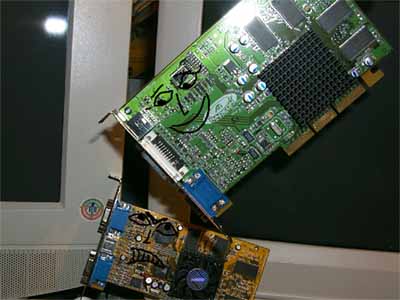 It may seem that video cards on NVIDIA chips have dominate every our review. I'm often accused of paying too little attention to ATI products. The main reason of such inequality is that only ATI produces video cards using ATI chips (only with the release of the RADEON LE they acquired a partner which helped ATI produce cheap modifications). It means that the series of boards made on the RADEON is strictly defined:
The cards mainly differ in types and frequencies of the memory, the graphics processor is the same but it also works at different frequencies. That's why the difference can be only in performance. And in VIVO complete set. Only the RADEON VE is too much unlike to its predecessors. During the last half year a lot of video cards on the GPU NVIDIA GeForce2 and especially GeForce2 MX hit the streets. And if they had looked identically, there would have been nothing to write about each card separately. But the cards can differ much even with the same reference design. The GeForce2 MX users know that the card can differ at least in 2D quality. Besides, there appeared a plenty of cards with peculiar features such as different memory types and sizes, hardware monitoring etc. Nearly all of them appear on the shelves, that's why we decided to cover as much cards on the popular chipset as possible. One of the key features of the NVIDIA GeForce2 MX is TwinView support. Certainly, the TwinView is supported not by all cards on the GeForce2 MX, but only by those which have the second RAMDAC and a connector for the second video-out or a TV-out. Such boards are too costy. There rises a question - what can ATI oppose to these cards? For quite a long time we had the comparison:
If in the first two positions the RADEON has lagged behind its competitor almost everywhere, in the third one the situation is ambiguous. In 32-bit color the RADEON 32 MBytes SDR easily outpaces the NVIDIA GeForce2 MX which can't be even supported by its newest versions. Besides, considering that today a lot of cheap RADEON LE cards appeared on the market which can be perfectly overclocked, and the GeForce2 MX is in curious circumstances. Besides, the RADEON VE has become a real danger for GF2. Here you can check the RADEON VE's specs:
As I can judge the RADEON VE is received by cutting two times the rasterized block, deleting the Hardware TCL block (i.e. the geomentrical coprocessor) and adding the units which output the image on the second signal receiver (the second RAMDAC, CRTC etc.) It looks like the GeForce2 MX coming from the GeForce2 GTS :-) except for the fact that the Hardware TCL wasn't deleted from the GeForce2 MX. So, we have recived the Riva TNT2 Ultra in terms of the 3D performance, but in another form. Look: the both have 150 MHz, in multitexturing mode the Riva TNT2 Ultra gives 150 million pixels and 300 million texels per second, as much as the RADEON VE if two texture blocks are activated (today it's still impossible to enable 3 TMUs since there are no such games). The Riva TNT2 Ultra runs at 183 MHz with the 128-bit bus. The RADEON VE operates at 183 (366) MHz of the DDR-memory, but taking into consideration the 64-bit bus we get the same. The unique technologies HyperZ and double caching allow RADEON VE to have higher performance than that of the 2 year Riva TNT2 Ultra. Board
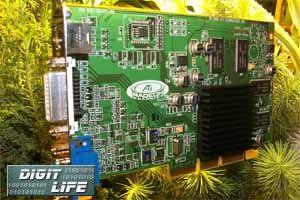  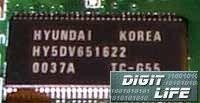 The board are based on the AGP 2x/4x interface, it has 32 MBytes DDR SDRAM memory located in 4 chips on the right side of the PCB. The memory modules have 5.5 ns access time and are intended for 183 (366) MHz. 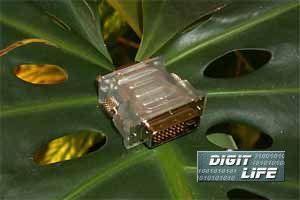 The chipset is covered with a heat sink, glued to it. The fan is absent since the processor does not heat itself much. Apart from the usual VGA-connecotor there is a DVI-output. These both outputs together with the integrated RAMDACs serve a base for the HydraVision technology which is similar to the NVIDIA TwinView or Matrox DualHead, but which is, at the same time, unique. Here is a quotation from the press release of November 9, 2000: "Toronto, Ontario, Canada, November 9, 2000 - ATI Technologies Inc. (TSE: ATY, NASDAQ: ATYT) the world's largest supplier of 3D graphics and multimedia technology, today announced an exclusive strategic relationship with Appian Graphics Corporation, the leader in extended desktop solutions, to bring HydraVision™ software to the mass market. The agreement gives ATI the rights to integrate the industry-leading HydraVision desktop management software and brand into their product line starting with the RADEON™ VE followed by other ATI products in the future. HydraVision has long been the standard desktop manager for multiple monitor products, and Appian Graphics has been the leader in offering the best multiple monitor solutions," said David Orton, President of ATI. "Combining Appian's desktop management expertise with our leading graphic accelerator technology will create an unbeatable line of products. Appian's patented HydraVision desktop management software provides users with an interface for simplified management of multiple displays. HydraVision features include window and dialog box control, hot-key shortcuts, independent resolutions and refresh rates, independent application control, and up to nine virtual desktops." So, this technology gives a possibility not only to display an image on two monitors but it also is handy in creation of virtual desktops. We will discuss it in depth a bit later, but now we will return to our discussion of the RADEON VE and its accesories. The complete set includes the adapter (on the photo above) which allows to connect not only the digital monitor but also a normal one to the second connector. 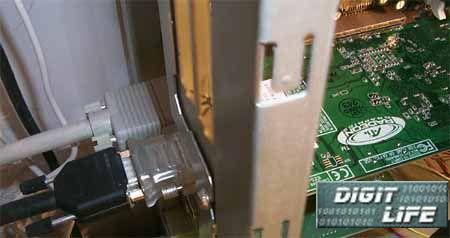 It should be noted that RADEON VE is equipped with a TV-out with an S- Video- connector (there is an S-Video-to-RCA adapter supplied). That's why you can display an image on any two of these three receivers. Settings for image output can be found in driver settings:  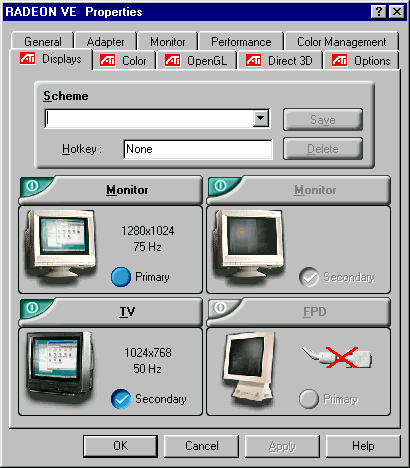 Note an important detail: you can interchange the receivers, i.e. the primary and the secondary receivers are not rigidly tied up to the corresponding connectors. That's why if you unintentionally connected monitors the wrong way, you can just interchange them in the drivers. It is interesting to note that the HydraVision utility allows to use the multimonitor support in almost all applications, even in the Adobe Photoshop:  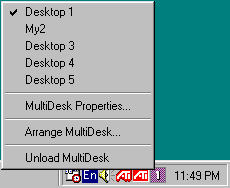 After installation of the utility you will see an icon of "HydraVision control" in the task bar. The program allows to organize up to 9 virtual desktops! You can shift from one to another desktop with only one switch. The desktops can be named however you like: 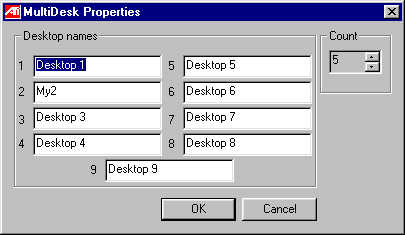 The card can be shipped either in OEM package or in Retail one. The complete set contains two adapters: DVI-to-VGA, S-Video-to-RCA, and a CD with drivers. OverclockingUnfortunately, there are no utilities which can correctly increase the clock frequency of the card, that's why we did not overclock the card. Installation and driversThe test system for the ATI RADEON VE:
The tests were carried out with VSync disabled, on the 7.078 drivers from ATI. For comparison we have taken the results of the following video cards: ATI RADEON 32 MBytes SDR, Hercules Dynamite TNT2 Ultra (the frequency was decreased down to 150/183 MHz which are standard for the Riva TNT2 Ultra), Leadtek WinFast GeForce2 MX/DVI. Test resultsThe 2D quality is traditionally high. There is nothing much to talk about; just note that 2D quality does not depend only on the card manufacturer but may vary from card to card. Besides, you'd better check whether your monitor satisfies the image quality demands that you make for your video card. Now let us look at the performance of the card in 3D. The following programs were used:
Quake3 ArenaThe test using the standard demo002 was carried out in two modes: Fast (shows card's work in 16-bit color) and High Quality (shows card's work in 32-bit color). 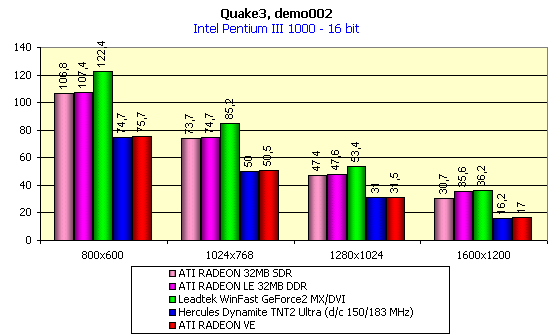  You can see that my guess-work on the results of the RADEON VE and the Riva TNT2Ultra being close turned out to be true. Only in 32-bit color the RADEON VE won the battle with RivaTNT2Ultra, but it fell far behind the other cards. ExpendableUsing this game we will evaluate the card's speed in Direct3D. 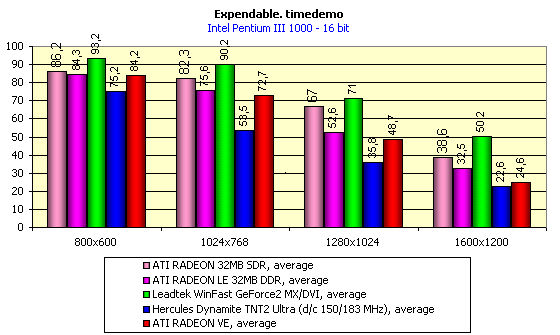 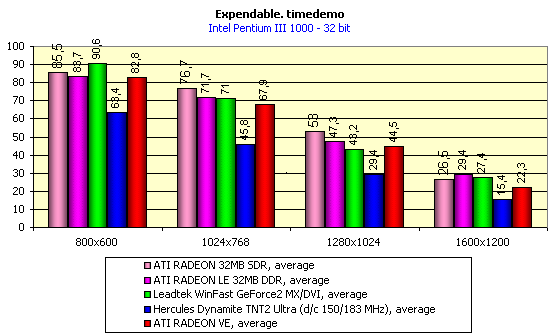 Here the situation is quite different: RADEON VE has a clear advantage over the Riva TNT2 Ultra. The RADEON VE could even outperform their elder brothers prominent in 3D. However, a relative ease of the scenes in the Expendable could also contribute to this effect. But there is another version that this might be the cause of the use of HyperZ. However, according to the Registry, it's included both in the OpenGL and in the Direct3D modes, and in the first case it's possible that the HyperZ operates the wrong way but in the Direct3D it gives out all its advantages. Now comes the summary on the ATI RADEON VE's performance:
ConclusionDespite low results in 3D, the RADEON VE showed a high level of price/performance/"function saturation" ratio. Priced at $90-95, the card remains far behind the NVIDIA GeForce2 MX - cards which have almost the same price, but the RADEON VE shows an excellent quality in 2D, what is untypical for "noname"-cards on the GeForce2 MX, plus it features the HydraVision technology which is similar to the NVIDIA TwinView. And such cards are much more expensive than $100. We can suggest that you buy the ATI RADEON VE if you are working mainly in business sector or in hardcore 2D-applications. It is a good choice for those who need to use two monitors at the same time. Besides, remember that as always ATI provides high quality of playback of DVD and MPEG4 movies. For proper comparison of video cards of this and other classes refer to our 3Digest. Highs:
Lows:
Write a comment below. No registration needed!
|
Platform · Video · Multimedia · Mobile · Other || About us & Privacy policy · Twitter · Facebook Copyright © Byrds Research & Publishing, Ltd., 1997–2011. All rights reserved. |